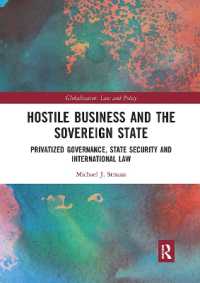- ホーム
- > 洋書
- > 英文書
- > Computer / General
Full Description
Gear up for course excellence and success on the latest CompTIA Cybersecurity Analyst certification exam with the advanced knowledge and essential cybersecurity skills offered in Ciampa's COMPTIA CYSA+ GUIDE TO CYBERSECURITY ANALYST, 3rd Edition. Stay ahead with updated content directly aligned to the CySA+ CSO-003 certification exam, gaining expertise in threat intelligence data analysis, internal and external vulnerability identification and mitigation and effective cyber incident response. Immerse yourself in new case projects and real-world examples that will take you on a captivating journey through actual on-the-job tasks and procedures, including hands-on experience with controls, monitoring, incident response and compliance. Further boost your understanding and performance with MindTap's interactive tools, empowering you to excel in the cybersecurity profession.
Contents
Part 1: CYBERSECURITY FOUNDATIONS.
1. Technology Underpinnings.
a. Infrastructures and Architectures.
i. Infrastructure Concepts.
ii. Network Architectures.
iii. Operational Technology.
b. Software.
i. Operating System Fundamentals.
ii. Coding (1.3c).
2. Threat Actors and Their Threats.
a. Who Are the Threat Actors?
i. Script Kiddie.
ii. Organized Crime.
iii. Insider Threat.
iv. Hacktivists.
v. Nation-state Actors.
vi. Others.
b. Threat Actor Actions.
i. Tactics, Techniques, and Procedures (TTP).
ii. Known and Unknown Threats.
c. Types of Attacks.
i. Web Server Application Attacks.
ii. Remote Code Execution.
iii. Data Poisoning.
iv. Obfuscated Links.
d. Vulnerabilities.
i. Programming Vulnerabilities.
ii. Broken Access Control.
iii. Cryptographic Failures.
iv. Dated Components.
v. Identification and Authentication Failures.
3. Cybersecurity Substrata.
a. Identity and Access Management (IAM).
i. Identity.
ii. Access.
b. Encryption.
i. Public Key Infrastructure (PKI).
ii. Secure Sockets Layer (SSL) Inspection.
c. Secure Coding.
i. Secure Software Development Life Cycle (SDLC).
ii. Secure Coding Best Practices.
d. Networking (1.1d).
i. Zero Trust.
ii. Secure Access Service Edge (SASE).
Part 2: SECURITY OPERATIONS.
4. Identifying Indicators of Attack (IOA).
a. Cybersecurity Indicators.
i. Indicators of Attack (IOA).
ii. Indicators of Compromise (IOC) (1.4f).
b. Network IOA.
i. Abnormal Network Traffic.
ii. Stealth Transmissions.
iii. Scan/Sweeps.
iv. Rogue Devices on a Network.
c. Endpoint IOA.
i. High-Volume Consumption of Resources.
ii. Operating System Evidence.
iii. Software-Related Evidence.
iv. Data Exfiltration.
d. Application IOA.
i. Unusual Activity.
ii. New Account Creation.
iii. Unexpected Outbound Communications.
iv. Application Logs.
5. Analyzing Indicators of Compromise (IOC).
a. Common Techniques for Investigating IOC.
i. Diagnose Malware.
ii. Analyze Email.
iii. User Behavior Analysis (UBA).
b. Tools for IOC Analysis.
i. File Analysis Tools.
ii. Tools for Analyzing Network IOC
iii. Reputation Tools.
iv. Log Correlation and Analysis Tools.
6. Threat Detection and Process Improvement.
a. Threat Intelligence.
i. What is Threat Intelligence (TI)?
ii. Threat Intelligence Versus Threat Data.
iii. The Intelligence Cycle.
iv. Threat Intelligence Sources.
v. Confidence Levels.
b. Threat Hunting.
i. What is Threat Hunting?
ii. Hunters and Hunting.
iii. Threat Hunting Methodologies.
iv. Steps in Threat Hunting.
c. Improving Security Operation Processes.
i. Standardize Processes.
ii. Streamline Operations.
iii. Tool Automation and Integration.
Part 3: VULNERABILITY ASSESSMENT AND MANAGEMENT.
7. Vulnerability Scanning and Assessment Tools.
a. Industry Frameworks.
i. Payment Card Industry Data Security Standard (PCI DSS).
ii. Center for Internet Security (CIS) Benchmarks.
iii. Open Web Application Security Project (OWASP).
iv. International Organization for Standardization (ISO) 27000 Series.
b. Vulnerability Scanning Methods.
i. Asset Discovery.
ii. Special Considerations.
iii. Types of Scanning.
c. Vulnerability Assessment Tools.
i. Network Scanning and Mapping.
ii. Web Application Scanners.
iii. Vulnerability Scanners.
iv. Debuggers.
v. Multipurpose.
vi. Cloud Infrastructure Assessment Tools.
8. Addressing Vulnerabilities.
a. Prioritizing Vulnerabilities.
i. Common Vulnerability Scoring System (CVSS) Interpretation.
ii. Validation.
iii. Context Awareness.
iv. Exploitability/Weaponization.
v. Asset Value.
vi. Zero-day.
b. Managing Vulnerabilities.
i. Using Controls.
ii. Patching and Configuration Management.
iii. Maintenance Windows.
iv. Exceptions.
v. Policies, Governance, and Service-level Objectives (SLOs).
vi. Prioritization and Escalation.
vii. Attack Surface Management.
viii. Threat Modeling.
9. Vulnerability Management Reporting and Communication.
a. Reporting Vulnerabilities.
b. Compliance Reports.
c. Action Plans.
d. Inhibitors to Remediation
i. Memorandum of Understanding (MOU).
ii. Service-level Agreement (SLA).
iii








